
The Wellcome Library’s Top 10 Open Images
THE WELLCOME LIBRARY - Catherine Draycott, head of Wellcome Images, gives a run down of the Top 10 most downloaded images from the collection of more than 100,000 that the Wellcome Library made available free from restrictions earlier this year.
June 3, 2014
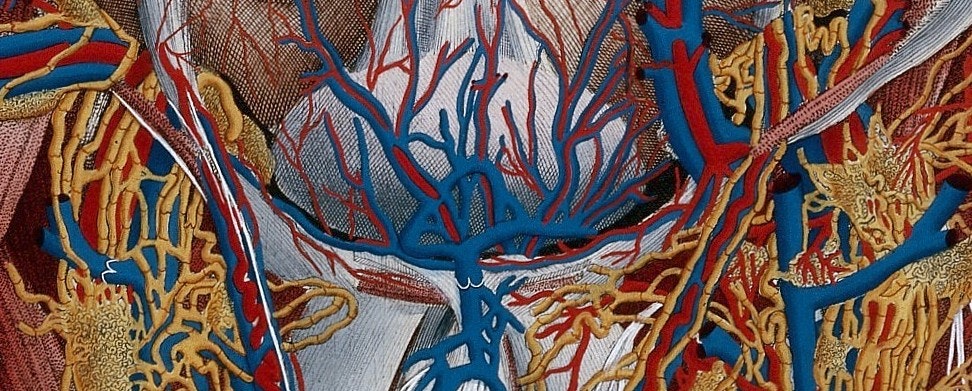 Scroll through the whole page to download all images before printing.
Scroll through the whole page to download all images before printing.On 20th January this year, over 100,000 images from the historical holdings of the world-renowned Wellcome Library were made freely available through the Wellcome Images website. They were released under the Creative Commons-Attribution only (CC-BY 4.0) licence and they can be downloaded directly from the Wellcome Images website for any personal or commercial use.
We introduced this radical change to promote usage and access to the Wellcome Library’s amazing resources. The Library is one of the world’s leading libraries of medical history and the human condition. It offers a rich body of historical images, the earliest of which is a 3000 year old Egyptian prescription on papyrus. Treasures include exquisite medieval illuminated manuscripts and anatomical drawings, ranging from delicate 16th century anatomical ‘fugitive sheets’ - literally, ‘flying sheets’ whose hinged paper flaps lift to reveal the layers of muscles and internal organs - to the most popular image to date; Paolo Mascagni’s vibrantly coloured etching of an ‘exploded’ torso.
Together the collection amounts to a dizzying and sometimes disturbing visual record of centuries of human culture, and our attempts to understand our bodies, minds and health through art and observation. We hope that the change will mean that this extraordinary collection, with all its variety and its many surprises, will be used by many more people and organisations in their books, magazines and films as well as for individual interest and research. The Wellcome Trust is already a leader in the field of open access and we want to make sure these images of the treasures in our collection, which have all been photographed with great care and skill over the years, can be used and enjoyed by anyone without restriction. We ask that Wellcome Library be credited for the images so that researchers and users are aware of the provenance and of the location of the original material in the photographs.
Since the release at the beginning of 2014, almost 65,000 high resolution images have been downloaded. Here is a run down of the top ten most downloaded images so far, showing the variety and range of the collection.
1. Paolo Mascagni’s Exploded Torso
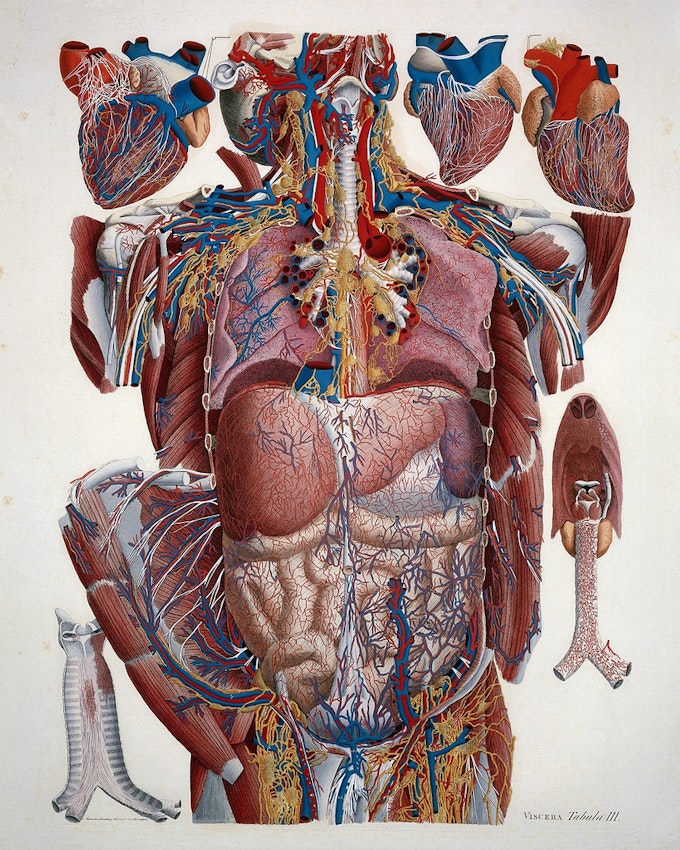 Scroll through the whole page to download all images before printing.
Scroll through the whole page to download all images before printing.Illustration of human viscera by Paulo Mascagni, from his Anatomia Universa (1823-31) - Source: Wellcome Library, London.
Coming a close second is the beautiful Persian horoscope created by hand in lapis lazuli and gold leaf for Prince Iskandar who was named after Alexander the Great and was the grandson of Tamerlane, the Turkman Mongol conqueror. The horoscope shows the positions of the stars and planets in the sky at the moment of Iskandar's birth on 25th April 1384. He died in 1415, only 4 years after the horoscope was made. The manuscript is an exquisite work of art and an exemplary production of the royal kitabkhana 'publishing house' or 'workshop'. Created in 1411, it is lavishly illustrated, not only on this beautiful fly leaf. It includes the work of astronomers (among them Imad ad-Din Mahmud al-Kashi), illuminators, gilders, calligraphers and craftsmen, as well as specialists in paper-making. The manuscript was bought in Iran in 1794 by John H. Harrington, who had started his career as a clerk in the East India Company. It was bought by Sir Henry Wellcome in 1932 at Sotheby’s for £6/15d only a few years before his death in 1936 at the age of 82.
3. A Head of Writhing Nudes
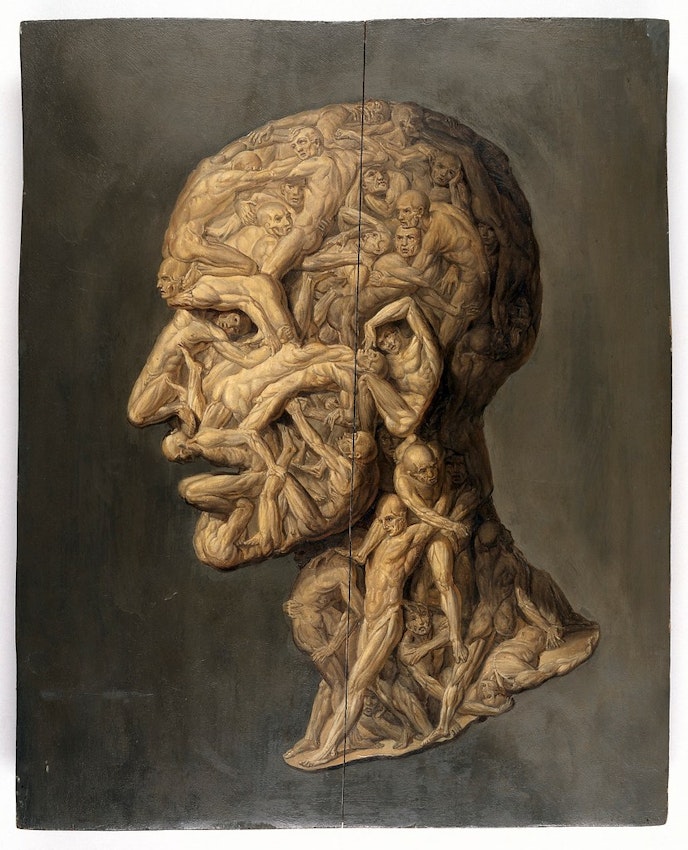 Scroll through the whole page to download all images before printing.
Scroll through the whole page to download all images before printing.Testa anatomica (1854); profile view of male human head composed of writhing, apparently tormented naked men, by Filippo Balbi - Source: Wellcome Library, London.
The third image is an oil painting by Filippo Balbi, Testa anatomica (anatomical head), which shows a man’s head in profile composed of writhing male nude figures. Painted in 1854, it was exhibited at the Universal Exhibition in Paris in 1855.
4.& 5. Venus Bathing
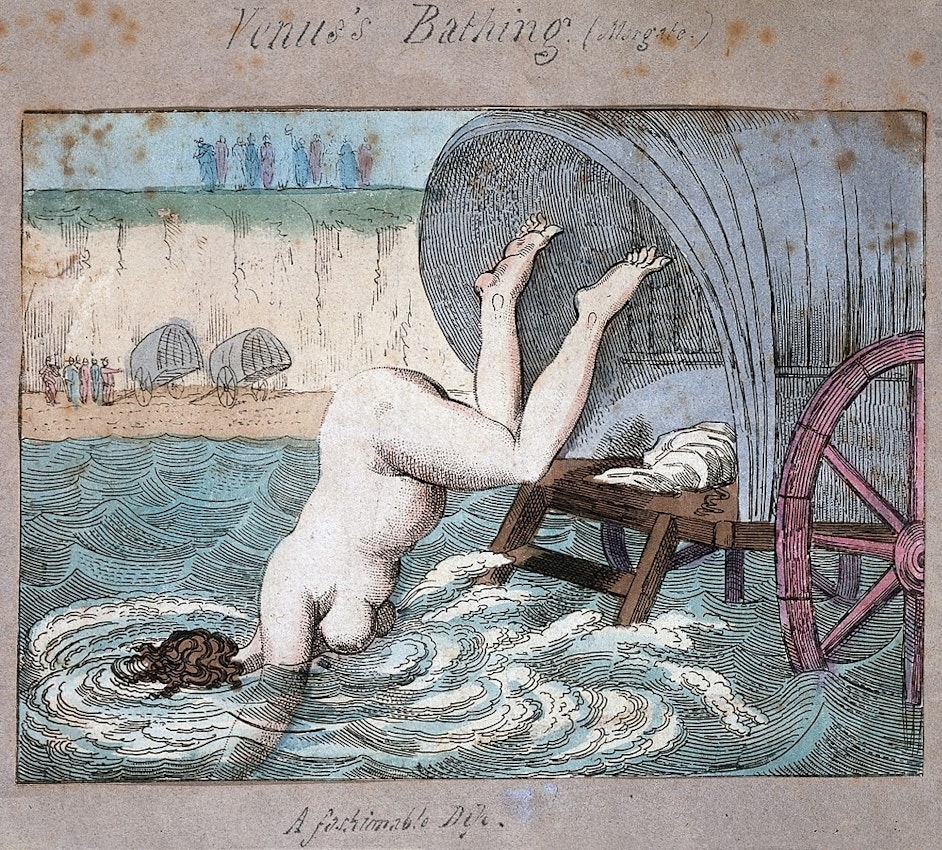 Scroll through the whole page to download all images before printing.
Scroll through the whole page to download all images before printing.Venus's Bathing (ca. 1790), a hand-etching by Thomas Rowlandson - Source: Wellcome Library, London.
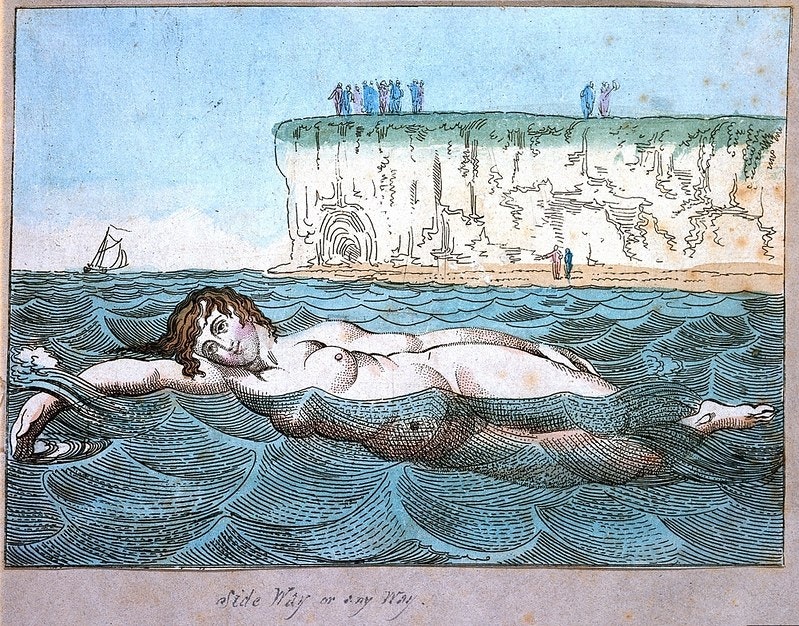 Scroll through the whole page to download all images before printing.
Scroll through the whole page to download all images before printing.Venus's Bathing (ca. 1800), a hand-etching by Thomas Rowlandson - Source: Wellcome Library, London.
Changing the mood completely, the next two images are delicately hand-coloured, gently humorous etchings of ‘Venus’s bathing’ by Thomas Rowlandson. Created in around 1800, they show a naked woman diving into the sea from a bathing machine; ‘A fashionable dip’ and swimming ‘Side Way or any Way’ at Margate with figures looking on from the white cliffs in the distance.
6. D'Agoty's Écorché of a Woman's Back
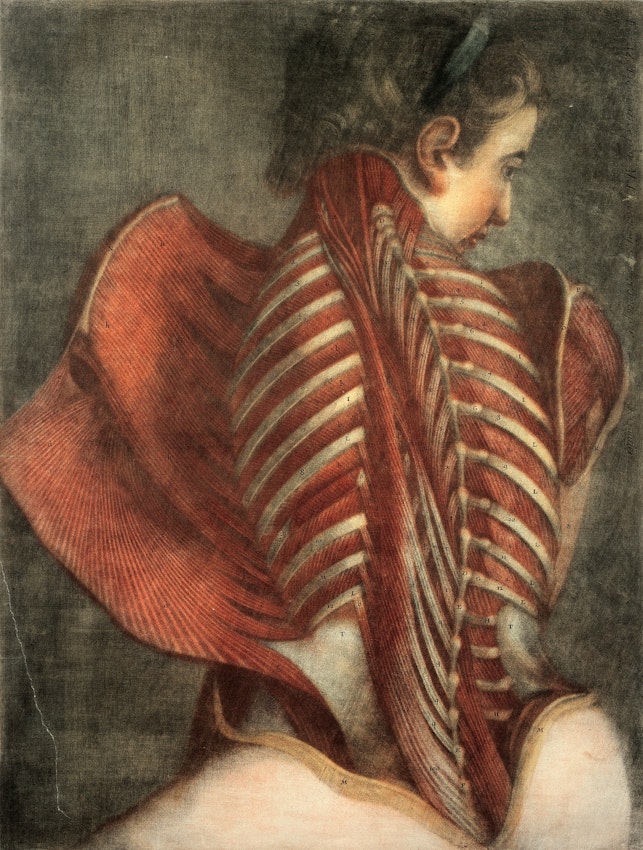 Scroll through the whole page to download all images before printing.
Scroll through the whole page to download all images before printing.A mezzotint écorché by Gautier D'agoty, published by Gautier in 1746 - Source: Wellcome Library, London.
On a more anatomical note, the next image, a mezzotint of a female écorché torso revealing the muscles of the back, shows the extraordinary talent of Jacques-Fabien Gautier d’Agoty who made this print after observing a dissection carried out by J. F. Duverney, a Parisian surgeon and anatomist. Mezzotint was a new technique developed by Jacob Christoph le Blon for whom d’Agoty worked as an assistant and to whose 3 colour process d’Agoty added black. The result has a velvety finish with the subtlety of a pastel drawing and the depth of an oil painting. The print is approximately life-size, (measuring 60.6cm x 45.6 cm) as are many of the other works by the same artist held by the Wellcome Library.
7. The Ripening of Karma
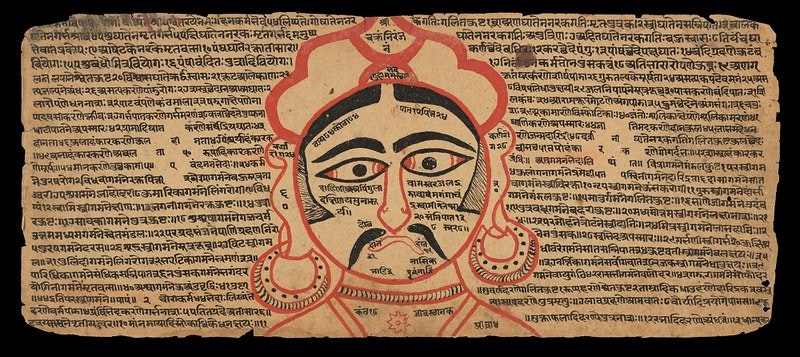 Scroll through the whole page to download all images before printing.
Scroll through the whole page to download all images before printing.Image from a Sanskrit manuscript, ca. 1469 - Source: Wellcome Library, London.
Returning to Asia, this image is from a Sanskrit manuscript thought to be from around 1469. This manuscript is from the genre of karmavipāka, meaning "the ripening of karma”. It begins with a salutation to the sage Dhanvantari, the traditional author of the original works on Ayurveda, one of the world’s oldest medical systems. It explains the karmic relationship with a given disaster or disease; listing various sinful acts together with a brief statement of the consequences that follow. For example; killing a cow will cause the killer to go to hell and having sex with a priest’s wife, the wife of another, a widow, or a prostitute, may lead to diseases such as ring-leprosy, bloody bile, or excessive urination.
8. Materia Medica from Tibet
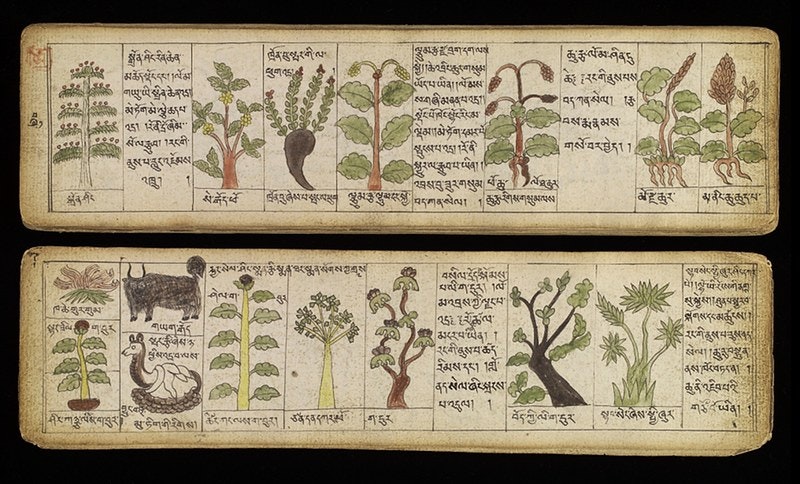 Scroll through the whole page to download all images before printing.
Scroll through the whole page to download all images before printing.Illustrations of Tibetan materia medica from Sman bla'i dgongs rgyan rgud bzhi'i nang gi 'khrungs dpe re zhig - Source: Wellcome Library, London.
The next image shows two leaves from a beautiful and fascinating Tibetan manuscript detailing traditional medicines. A manuscript such as this would often have been carried by a Tibetan doctor to refer to while treating patients. Its name is Sman bla'i dgongs rgyan rgud bzhi'i nang gi 'khrungs dpe re zhig 'A Selection of Substances used for the Production of Medicine based on the Teaching of the four medical Tantras'. It has illustrations of all the materia medica, plants or animal, described and is composed of unbound, thick paper sheets, held together by two wooden boards and wrapped in cloth.
9. Wound Man
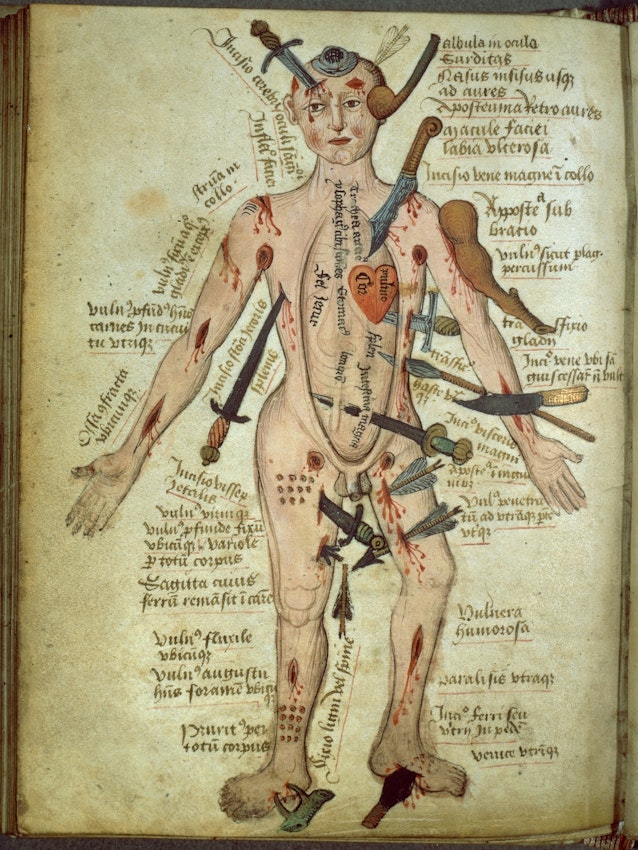 Scroll through the whole page to download all images before printing.
Scroll through the whole page to download all images before printing.Wound Man image from Claudius (Pseudo) Galen's Anathomia - Source: Wellcome Library, London.
This figure, from a 15th century English anatomical manuscript, is an example of a ‘wound man’. Figures like these can be found in a number of manuscripts and printed books produced in the 15th and 16th centuries. This particular version is folio 53 verso from Anathomia by Claudius (Pseudo) Galen. It is captioned in Latin and the words do not provide any directions for treatment but merely describe the injury: for example, 'penetration by a sword' or 'an arrow whose point has remained in the thigh'. The weapons are shown as they pierce the body and here, the positions of the man’s internal organs are indicated. The exact purpose of the wound man image is not known, but it might have served as a reminder of the injuries to which the human body is prone. These typically range from blows to the head, to stab wounds and arrow piercings, sometimes even showing dogs or snakes biting the legs.
10. A Chinese Manchu archer
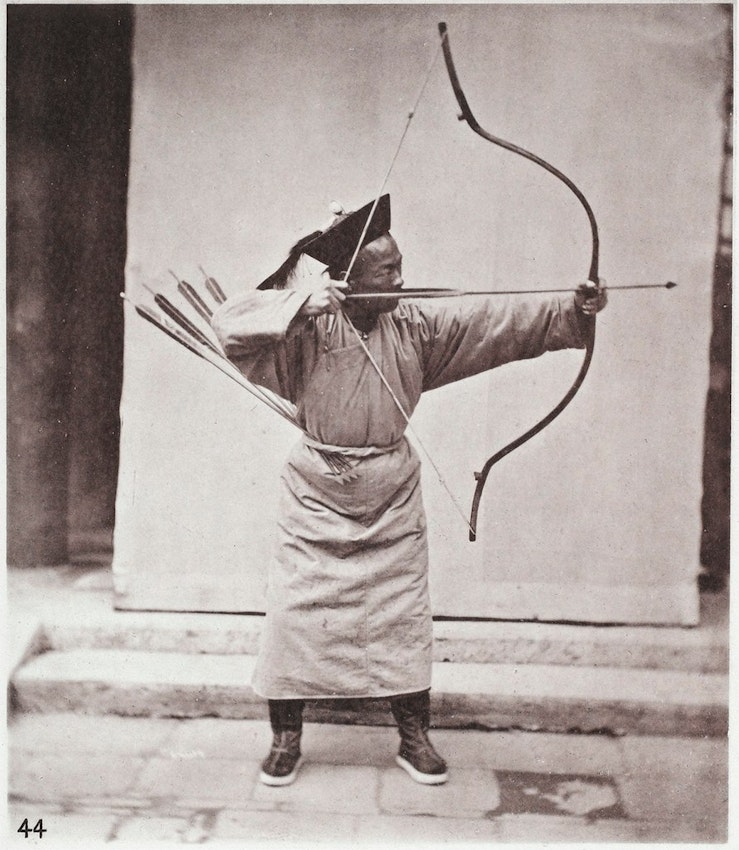 Scroll through the whole page to download all images before printing.
Scroll through the whole page to download all images before printing.A Manchu Archer, from the North of China, with his bow and arrow, a photograph John Thomson from his Illustrations of China and its people (1874) - Source: Wellcome Library, London.
The final image is a photograph of a Chinese Manchu archer in action, taken in 1874 in China by Scotsman John Thomson published in his book Illustrations of China and its people : a series of two hundred photographs, with letterpress descriptive of the places and people represented. Published in London in 1874, this photograph is from volume 4, plate 17 image number 44.
These and many thousands more high resolution images have been free now since 20th January 2014 and, since then, over 65,000 high resolution images have been downloaded. Take a look at wellcomeimages.org to discover more treasures. New images are added every week as we photograph more from the Library’s collections.
Catherine Draycott has been Head of Wellcome Images since 1992. She was a Director of the British Association of Picture Libraries and Agencies from 1997 to 2011 and was its Chairman from 2000 to 2007. She is responsible for the management and development of Wellcome Images' collection which spans the history of medicine and civilisation from antiquity to the present day with over 180,000 images available online. In 2008 she was awarded the Royal Photographic Society’s Combined Royal Colleges Medal for contribution to the use of images in medicine.








